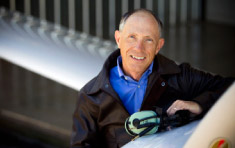22 years of retrospective
The aviation world is much changed since 1992
 After more than 45,000 hours in the left seat of the AOPA Foundation, the Air Safety Institute (ASI), and its predecessor—the AOPA Air Safety Foundation (ASF)—it’s time to move to the jump seat and let a new crew pick up the flight.
After more than 45,000 hours in the left seat of the AOPA Foundation, the Air Safety Institute (ASI), and its predecessor—the AOPA Air Safety Foundation (ASF)—it’s time to move to the jump seat and let a new crew pick up the flight.
The aviation world is much changed since 1992, when I came to AOPA from FlightSafety International. The GA safety record is better—as measured by actual accident numbers—and so is the rate, as best as that can be estimated. It seemed a good bet that the problem would be largely solved by now, although pilots have proven to be not especially creative but just stubborn when it comes to wrecking aircraft—so don’t get too comfortable in the cockpit just yet.
The term “data-driven” is overused but it’s one area where we’ve excelled. Robbers hit banks because that’s where the money is, and we’ve focused on the big killers because that’s where lives can be saved. Full credit for the concept goes to my predecessor, Don Engen, who as a former FAA administrator and NTSB member was appalled at how little factual evidence was easily available from the government regarding the GA safety picture. It’s helped AOPA make a compelling case for third class medical reform and toward a more rational approach to aircraft certification. The Joseph T. Nall Report on annual GA accidents has become the industry standard, providing solid factual information to educate the most cynical bureaucrat and sensationalist “investigative reporters,” but alas, that goal has also remained elusive.
ASI has put major effort into helping the CFI, “the most important person in aviation.” However, only a few in the business actually support that notion as shown by compensation, benefits, or real growth opportunities. We decided that the way GA training is taught needed to catch up to the twenty-first century.
The renewal process that CFIs must go through every two years needed streamlining. Back in the day, one had to endure 24 hours of sitting in a hotel ballroom listening to whatever the feds thought was important. We successfully persuaded the FAA to reduce this to 16 hours. The ASI course is offered both live and online and admittedly subjectively, ours is a far superior product compared to the competition. It’s the only national non-profit program that’s not just a profit-making venture. The arrival of the Internet changed the nature of education and ASF led the way with online training. We conduct nearly 200 live safety seminars, but taking a well-engineered and entertaining course anytime, anywhere is a fabulous alternative. More pilots complete ASI online courses every two months than the yearly attendance at live programs. The outreach numbers in courses, quizzes, and other education well exceed one million every year—and the number is growing. Sadly, that doesn’t reflect individual pilots, since our population has declined, but those who’ve stayed are getting more and better safety education faster.
The relationships with parts of the FAA, the NTSB, the National Weather Service, the National Air Traffic Controllers Association, and a broad variety of type clubs and pilots groups have never been better. Much of that remains behind the scenes, which is good when sausage is being made. Open, friendly discussion and logic actually works, sometimes. I’ve said there should be no politics in safety—and I know there is no safety in politics. One is wishful thinking and the other is fact.
Aircraft need fuel to fly and so do foundations. The AOPA Foundation has done well, but fewer than six percent of AOPA members give anything to support our efforts. There’s still work to do here, and if everyone gave a little (or more) the benefits would be significant. Having been an AOPA member for exactly twice as long as being an employee, I always thought that my dues covered all the critical and neat stuff the association offered. It’s not even close and seeing this from the inside gives one a far greater appreciation on just how essential AOPA is to preserving GA. That sounds self-serving until one looks at other countries (just about all of them) where GA has been decimated by governments—often under the guise of perfect safety using airline-style regulation.
The team at AOPA, the AOPA Foundation, and Air Safety Institute are first class and absolutely dedicated to the job they do so well. I will continue as senior safety advisor to support AOPA and the Air Safety Institute. The new team of Jim Minow, taking command of the AOPA Foundation—and George Perry, running the Air Safety Institute—will carry on in fine fashion. Thanks to all of you for a wonderful experience and for past and future support. But enough reminiscing—let’s do some flying. See you on the ramp!
Web: www.airsafetyinstitute.org
Bruce Landsberg steps down as president of the AOPA Foundation at the end of 2014. His column, blog, and “Landmark Accident” series will continue.


